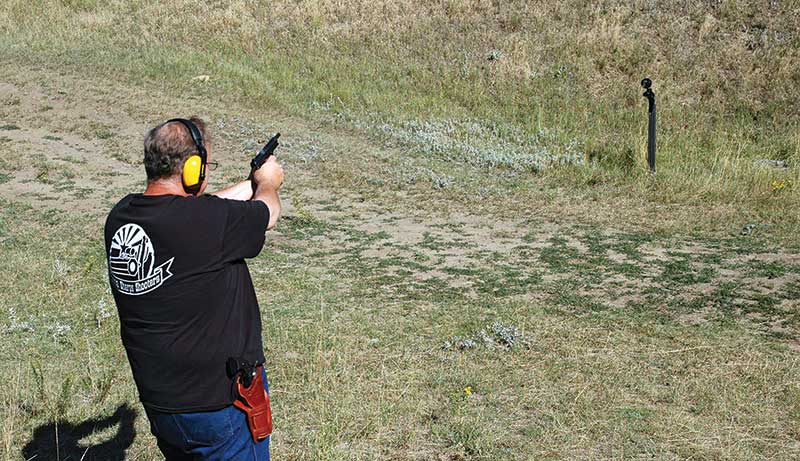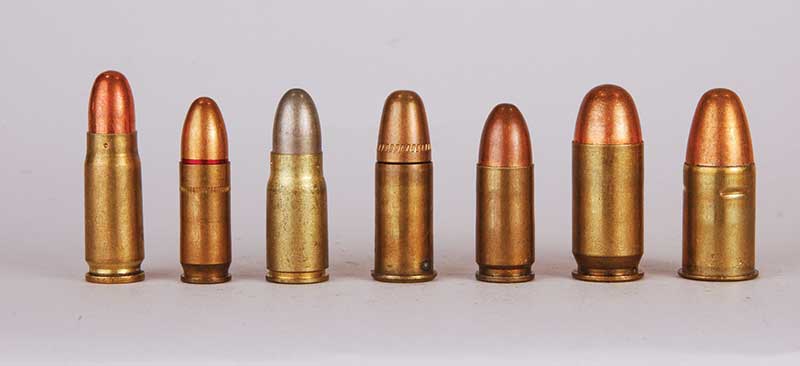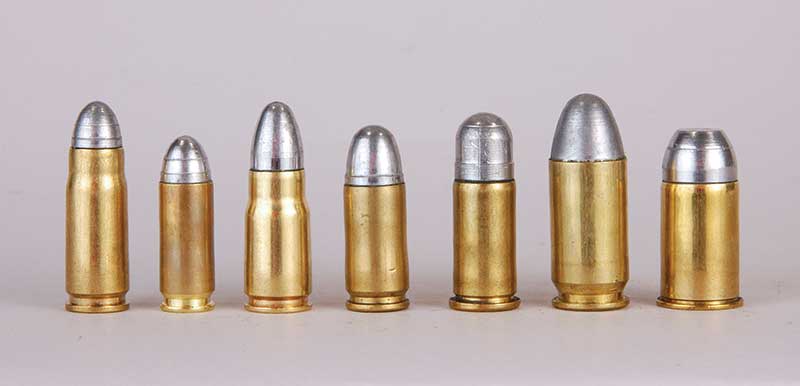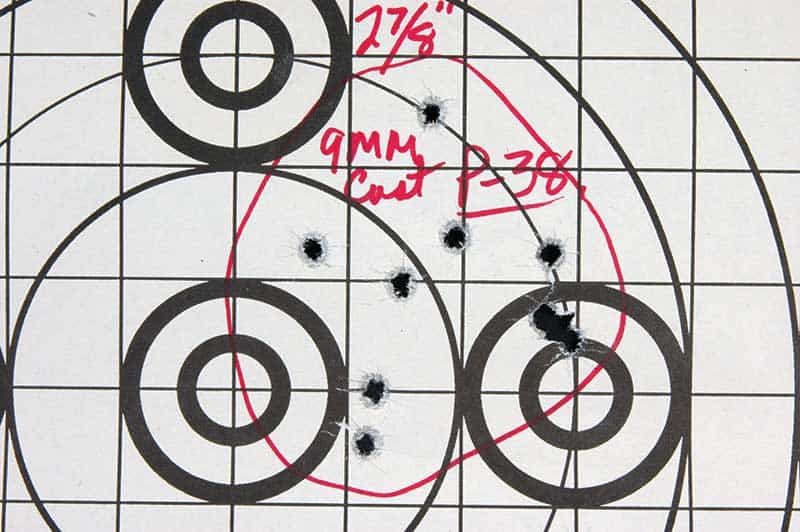World War II handgun case shapes and styles were also all over the map and these factors affect how the handloading must be done. The Soviets and Japanese liked rimless bottleneck cases. The Soviet Tokarev case dimensionally was merely a copy of the old 7.63 Mauser case design and can actually be handloaded with dies and brass for the Mauser round. Conversely the Japanese 8mm Nambu doesn’t match any other case before or since. In fact the proper RCBS shell holder for it fits no other cartridge. Naturally the British revolver cases are rimmed but the American’s adapted their rimless .45 Auto case to also fit revolvers by means of 3-round “half-moon” clips stamped of spring steel. The 9mm Parabellum is a straight, rimless case but the French 7.65mm Long case is straight and semi-rimmed.
Case shapes are also important factors because of the type of crimp that must be applied—and surely a crimp of some sort is necessary with all these cartridges. With the semi-auto pistol rounds the bullet must be locked in place, otherwise it could be pushed back into the case as the cartridge is fed from magazine, up the feed ramp and into the chamber.
When that happens pressures skyrocket. That I found out over 30 years back when a 9mm case wall blew out for just that reason. With the revolvers an uncrimped bullet will move in the opposite direction during recoil, which I discovered over 40 years ago when a 225-grain cast roundnose fell out the front of my S&W Model 1917’s cylinder and bounced off my toe.
Cast Bullets & World War II Handguns
When You Do It Yourself, You May Never Run Out Of Ammo For Even The Most Obscure Calibers
In building my shooting collection of World War II firearms I’ve accumulated most of the handguns considered “standard issue” by the major combatant nations. They range from a rather small and graceful French Model 1935A 7.65mm Long semi-auto to the huge and ungainly British .455 Webley Mark VI revolver.
However, there is a paradox to my shooting with these handguns. Their wartime ammunition carried full metal-jacketed (FMJ) bullets as decreed by the Geneva Convention. The paradox arises because I am almost exclusively a cast bullet shooter in regards to all handguns. I can’t see any sense in firing away expensive jacketed bullets when lead alloy ones can serve the same purpose at a fraction of the cost—especially if the shooter is willing to pour them himself.
So over these past few years I’ve devoted time and energy to working up accurate shooting and perfect functioning cast bullet handloads for the following WWII handgun cartridges: Soviet 7.62x25mm Tokarev, French 7.65mm Long, Japanese 8mm Nambu, British .380 Revolver, German 9mm Parabellum, American .45 Auto, and British .455 Webley. Of no less than 17 handguns chambered for these cartridges I’ve only failed to come up with a good cast bullet load for one—and surprisingly it is a revolver. More on that shortly.
If military bullet weights and ballistics are approximated odds are better that the handloads’ points of impact will coincide with the handguns’ points of aim. You see, without permanent alteration to these collectible handguns their sights’ adjustability range from zero with the Smith & Wesson revolvers to good with a few of the semi-autos. Here’s an example of the differences. My Canadian Inglis/Browning P35 has a dovetailed front sight so different blade heights can be installed to adjust elevation and the blade can be drifted laterally for windage adjustment. Conversely, my FN/Browning P35 has a staked in front sight that is not adjustable at all.
World War II military handgun cartridges vary considerably. The Brits bought into the heavy bullet at very low velocity concept. Their .455 Webley load used a 265-grain bullet at 620 fps and their Enfield No. 2 .380 Revolver load had a 178-grain bullet at 600 fps. Conversely the Soviets thought lightweight, speedy handgun bullets were better. They loaded their 7.62x25mm Tokarev ammo with 86-grain bullets at 1,500 fps. In diameter, World War II handgun bullets ranged from .307″ for the 7.62x25mm to .455″ for the big Webley.
In regards to picking cast bullet alloys the nominal velocities of these cartridges have much bearing. For my shooting, if the cartridge’s velocity falls under about 1,000 fps, then I use 1-20 tin-to-lead alloy which has a Brinell Hardness Number (BHN) of 10. Over 1,000 fps then I use linotype with a BHN of about 22. Please note, however, I’m not saying these are necessarily the optimum choices. For me they are the most convenient because I always keep a large supply of both those blends on hand. Likewise I only use one lube—the SPG brand because it also works great for black powder loading. And my choices of cast bullet sizing diameter are likewise narrow—from barrel groove diameter to .001″ over that.

The 17 World War II handguns for which Duke has been developing cast bullet handloads include (from left,
top to bottom) Soviet TT33 7.62x25mm, French Model 1935A 7.65mm Long, Japanese Type 14 8mm Nambu,
German P08 (Luger) 9mm; (2nd row, top to bottom) German P38 9mm, FN/Browning P35 9mm, Canadian
Inglis/Browning P35 9mm, Canadian Inglis/Browning P35 9mm with shoulder stock (Chinese contract);
(3rd row, top to bottom) British Enfield No. 2 .380 Revolver, S&W Victory Model .380 Revolver (British issue),
US Colt 1917 .45 ACP, US S&W Model 1917 .45 ACP; (4th row, from top to bottom) US Colt 1911 .45 ACP,
US Colt 1911A1 .45 ACP, S&W (Canadian) 2nd Model Hand Ejector .455 Webley, British Webley Mk VI .455,
US Model 1911A1 (new manufacture).
The British revolver rounds can receive a standard roll crimp. The same is true with the bottlenecked semi-auto Soviet and Japanese cases. Actually a roll crimp could also be used with the French semi-rimmed case without impairing functioning. Rimless 9mm Parabellum and .45 Auto rounds should be taper-crimped, although in the case of the latter caliber a roll crimp could be used if the rounds were only going to be fired in a revolver. Because I use a set of .32 Auto dies for reloading the French 7.65mm Long and they contain a taper-crimp seating die, that’s how bullets are secured in that caliber.
One factor all WWII handgun cartridges have in common is they are of modest capacity, essentially meaning they are short. The Soviet/Tokarev case is only .97″ in length and it’s about the longest. At the other end are the British revolver cartridges at .75″ and .76″ for the .455 Webley and .380 Revolver respectively. This factor is important in regards to powders used. Because of the limited capacity only the faster burning pistol propellants have application. Such range from Bullseye to Unique. Those two plus Titegroup and W231 are what I use.
For this article I’m going to limit myself only to bullets cast by myself using Lyman, Redding-SAECO and RCBS moulds. (For the non-caster various commercial bullet makers can supply similar ones that will work just as well.) For an accuracy standard I feel if all of these 17 handguns will group bullets into about 3″ at 25 yards then they are suitable. They may have been very serious handguns in their day but for me they are only recreational shooters. When time allows and I head down to my steel target range for some fun shooting, a variety of the above handguns are likely to be with me. Usually the ammo for them carry cast bullet as described herein.
Hornady
P.O. Box 1848
Grand Island, NE 68802
(308) 382-1390, www.hornady.com
Huntington Die Specialties
601 Oro Dam Blvd
Oroville, CA 95965
(530) 534-1210, www.huntingtons.com
Lyman
475 Smith ST.
Middletown, CT 06457
(860) 632-2020, www.lymanproducts.com
RCBS
605 Oro Dam Blvd, Oroville, CA 95965
(800) 553-5000, www.rcbs.com
Redding Reloading Equipment
1089 Starr RD.
Cortland, NY 13045
(607) 753-3331
www.redding-reloading.com
Starline Brass
1300 W. Henry
Sedalia, MO 65301
(660) 827-6640, www.starlinebrass.com
Tom Sargis, Bozeman Trail Arms
28 Lake DR., Livingston, MT 59047
Cartridge: 7.62x25mm Tokarev
Gun: Russian TT33, 4.63″ barrel
This is the only one of the 17 WWII handguns shown I don’t actually own. It belongs to my friend and gunsmith Tom Sargis. With 1986-dated Romanian military surplus ammo this pistol gave an honest 1,501 fps. I load it with 84-grain RCBS 32-085RN bullets sized to .311″ over 6.0 grains of Unique in Starline brass. Functioning is perfect and velocity is 1,452 fps. Close enough!
Cartridge: 7.65mm Long
Gun: French 1935A, 4.33″ barrel
This is my most recent WWII handgun purchase, bought more because one just like it was my very first handgun than because of its historical significance. A 32-round box of French military surplus ammo dated 1953 was purchased also so it could be checked for velocity. That’s a joke: not one single round of it would fire. Only Bertram of Australia makes ready-to-load brass for this caliber. The same RCBS 84-grain, .311″ roundnose used with the Tokarev is loaded over 3.0 grains of Titegroup. Functioning is perfect and velocity is 890 fps.
Cartridge: 8mm Nambu
Gun: Japanese Type 14, 4.61″ barrel
In the past I swore I would never spend my hard-earned gun’riter bucks on such an odd looking pistol but now I’m glad I did. It functions perfectly, shoots accurately, and always gets me some attention when I unholster it in front of other shooters. Unfortunately, since Japan was the only nation to use this cartridge I can’t find any military surplus ammo to test-fire to set a standard. Nor are factory loads available. Various sources say military loads were rated at “about” 1,000 fps with 110-grain bullets. To my great joy RCBS makes a special order, double-cavity mould 8mm-110-NAMBU. Bullets from mine drop at 106 grains of linotype and measure .324″. I size them to .323″ and load them in HDS headstamped brass (made by Starline) over 3.5 grains of Titegroup. The chronograph said my load hits 999 fps.
Cartridge: .380 Revolver
Guns: British Enfield No. 2, 5″ barrel; S&W Victory Model, 5″ barrel
This is one WWII handgun cartridge for which I have not been able to find a bullet close to the original military one in weight. Also, both my revolvers so chambered shoot to the sights with a 200-grain bullet. So my load uses Lyman 358430 over 1.7 grains of Titegroup, again in Starline brass. That bullet falls from the mould at .359″, so all that running it through a .360″ sizing die does is put lube on it. From the little Enfield No. 2 velocity is about 610 fps and from the S&W it is 15 fps more. Both of those revolvers are delightful plinkers with such mild loads but this sure seems like a silly excuse for a military handgun cartridge.
Cartridge: 9mm Parabellum
Guns: Inglis/Browning P35, 4.72″ barrel; FN/Browning P35 4.72″ barrel; P08 Luger (Mauser), 4″ Barrel; P38 (Mauser)
5″ barrel
Of all my WWII handguns these 9mms most rival the big 1911 autos in my heart’s affections and the Browning-designed P35s are my favorites. The German P08 and P38 occasionally fail to feed or eject with my cast bullet handloads. The P35s have never once failed to function. My bullet for them is Lyman 356242, a 120-grain roundnose that comes from the mould at .357″ and run through a sizing die of the same diameter. Lyman only makes this design available in a 2-cavity version but if they ever offer it in a 4-cavity mould I want the first one. The ammo I used to set a standard is headstamped FC88, which is Federal and made for NATO. From these five handguns it chronographed from a low of 1,120 fps (Luger) to a high of 1,190 fps (P38). With the 120-grain cast bullet a charge of 4.4 grains of W231 hits from 1,120 to 1,160 fps—again close enough! I don’t bother segregating my 9mm brass by headstamp.
Cartridge: .45 ACP
Guns: Colt 1911, 5″ barrel (made: 1918); Colt 1911A1, 5″ barrel (made: 1944); Colt 1911A1, 5″ barrel (early 20th century mfg.); Colt Model 1917, 5-1/2″ barrel; S&W Model 1917, 5-1/2″ barrel
If I could only pick one of my WWII handguns it would be one of the 1911s. I also shoot the Colt 1917 well in single action mode. In double action I would have trouble hitting a barn with it. The S&W Model 1917 has been my single failure to date to get adequate performance with cast bullet handloads. It merely tumbles every cast bullet I’ve fired through it—and believe me I know lots of tricks and techniques to make cast bullets shoot well. I started handloading the .45 ACP in 1968 with a 1-cavity Lyman mould for bullet 452374, dropping 225-grain roundnoses. That mould has now been replaced with a 4-cavity one of the same number but its bullets only weigh 220 grains. They are sized .452″. At a gun show I picked up some US military surplus .45 Auto headstamped WCC66. It chronographs 825 to 850 fps from all the above handguns except the S&W 1917. For some reason probably related to why it won’t shoot cast bullets it clocks about 100 fps less than the other .45s. Regardless, a charge of 5.4 grains of W231 essentially duplicates military ballistics. As with 9mm I don’t segregate my .45 Auto brass.
Cartridge: .455 Webley
Guns: Webley Mk VI, 6″ Barrel; S&W Hand Ejector No. 2, 6-1/2″ barrel
Along the lines of the Brits’ .380 Revolver round, the .455 Webley pretty much follows down the “pitiful excuse for a military revolver cartridge” path. Why they figured such a big caliber needed such a small case is a mystery. Anyway, Hornady now makes brand new brass for it and even a factory load. From my two .455s that load gives right at 600 fps, give or take a few fps. RCBS makes a special order mould 455-265 Webley that is even hollowbase as were original bullets. It drops a 260-grain conical shaped bullet, but as with all hollowbase or hollowpoint designs it is very slow to cast. To fill the gap, I’ve turned to Redding-Saeco’s mould 955, nominally for a 255-grain roundnose/flatpoint (RN/FP) intended for the .45 Colt. From my 1-20 tin-to-lead alloy it drops from the mould at 454″ and is sized the same. Weighing 264 grains, it prints to the sights in both my .455s. Because this bullet seats deeper than the RCBS one the powder charge is reduced to 3.0 grains of Bullseye. The chronograph says it is moving at 620 to 630 fps from both my .455s.












